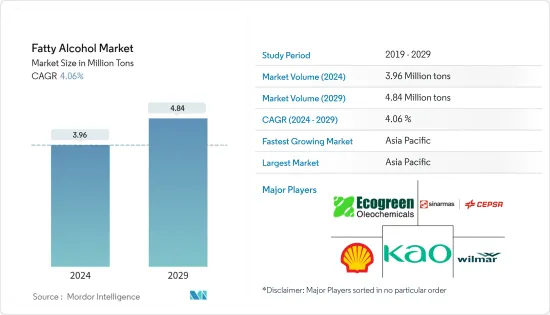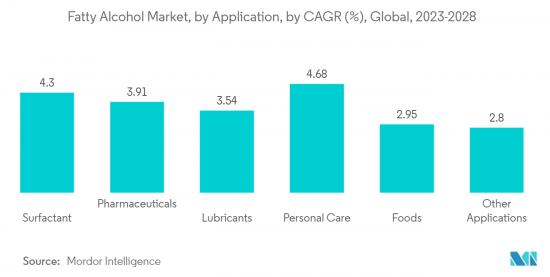 |
市場調查報告書
商品編碼
1406098
脂醇類-市場佔有率分析、產業趨勢與統計、2024-2029 年成長預測Fatty Alcohol - Market Share Analysis, Industry Trends & Statistics, Growth Forecasts 2024 - 2029 |
||||||
※ 本網頁內容可能與最新版本有所差異。詳細情況請與我們聯繫。
脂醇類市場規模預計到2024年為396萬噸,預計到2029年將達到484萬噸,在預測期內(2024-2029年)複合年成長率為4.06%。

市場受到 COVID-19 的負面影響。多個國家已進入封鎖狀態,以遏止疫情蔓延。許多企業和工廠被關閉,擾亂了世界各地的供應鏈,損害了全球生產、交貨時間表和產品銷售。目前,脂醇類市場已從COVID-19大流行的影響中恢復,並呈現顯著成長。
主要亮點
- 從中期來看,製藥業需求的增加以及個人護理和化妝品中脂醇類使用量的增加預計將成為市場的主要推動要素。
- 另一方面,原物料價格急劇上升預計將成為市場的抑制因素。
- 對生物基脂醇類產品的需求不斷成長可能對未來幾年的市場來說是個好兆頭。
- 亞太地區佔據最高的市場佔有率,預計在預測期內將繼續保持主導地位。
脂醇類市場趨勢
表面活性劑應用主導市場
- 脂醇類主要用於生產清潔劑和界面活性劑。脂醇類是雙親性的,因此充當非離子表面活性劑。
- 脂醇類是 C6 至 C22 伯醇,通常是直鏈的,這種類型用於清潔劑行業。現代清潔劑最初是基於由脂醇類原料製成的表面活性劑。這些包括天然脂肪和蠟,最近也從各種碳氫化合物來源合成了高分子量醇。
- 世界上大部分脂醇類都轉化為界面活性劑和界面活性劑,是生產洗衣精、餐具清潔劑和其他家用清洗產品的基本原料。
- 根據國際貿易中心統計,德國是最大的肥皂和有機界面活性劑出口國,出口額從2019年的118.2億美元大幅成長至2022年的145.4億美元。這種成長意味著國際市場對這些產品的需求增加,從而導致對作為界面活性劑生產關鍵成分的脂肪酸的需求增加。
- 中國化學工業的產品對於肥皂、清潔劑和化妝品等多種產品至關重要。超過 60 家洗衣、護理和清洗產品製造商的存在證實了該行業的競爭力。此外,中國每100戶家庭擁有洗衣機約98.7台,清洗產品的消費群也不斷擴大。中國消費電器產品的崛起及其對價格實惠產品的關注增加了洗衣機的使用範圍和對清潔劑的需求。
- 此外,印度是世界領先的肥皂生產國之一。該國人均香皂和沐浴皂消費量量約800公克。人均香皂和沐浴皂消費量800公克左右,顯示國內肥皂產品需求穩定。此外,家庭和個人護理領域約佔印度快速消費品市場50%的佔有率。合成合成清潔劑中間體產量從2019年的714,680噸持續成長到2022年的78萬噸以上,顯示清潔劑產品的需求正在增加。因此,作為界面活性劑生產原料的脂肪酸的需求將隨著印度清潔劑市場的擴大而成長。
- 預計這些因素將在未來幾年增加對脂醇類的需求。

亞太地區主導市場
- 中國、印度和日本等主要國家對表面活性劑、個人護理/化妝品和藥品等各行業的需求很高,預計這將推動市場估計和預測期間的市場研究。
- 中國是全球第二大化妝品消費國。根據歐萊雅的報告,2022 年該國美容和個人護理市場總產值達 553 億美元。在經歷了因經濟不確定性、大量企業倒閉和其他疫情政策變化導致的放緩後,該國美容市場在 2022 年呈現強勁復甦。
- 我國合成清潔劑生產主要集中在廣東、浙江、四川三省,年生產量分別為325萬噸、114萬噸、109萬噸。
- 中國的製藥業是世界上最大的製藥業之一。我們涉及學名藥、治療藥物、原料藥和草藥的生產。在日本註冊的藥品90%以上都是學名藥。截至 2022 年,該國擁有規模龐大且多元化的國內製藥業,約有 5,000 家製造商,其中許多是中小企業。
- 根據國家投資促進和便利化局(Invest India)的數據,印度在美容和個人護理(BPC)市場中排名第八。意識的提高、獲取的便利性和生活方式的改變等因素正在推動市場的發展。印度個人衛生用品市場預計年終將達到150億美元。
- 洗髮精中使用的脂肪酸甲酯可以有效去除頭髮上的皮脂和固態顆粒等污垢。根據印度國家投資促進和便利化局(Invest India)預測,未來兩年印度護髮市場規模預計將達到48.9億美元,複合年成長率為6.6%。
- 為了促進日本化妝品產業的成長,2023年4月,東京化妝品工業聯合會、日本化妝品工業聯合會、西日本化妝品工業聯合會、中部化妝品工業聯合會合併,成立日本化妝品工業聯合會(日本化妝品工業聯合會.JCIA)成立。日本化妝品產業主要企業之一的花王株式會社發布的報告顯示,去年日本化妝品市場整體成長超過3%,預計未來幾年將進一步成長。
- 由於該地區終端用戶行業的快速成長,預計在預測期內對脂醇類的需求也會增加。
脂醇類產業概況
全球脂醇類市場較為分散,市場上存在大中型企業。市場主要企業(排名不分先後)包括 PT.Ecogreen Oledochemicals、殼牌 PLC、花王公司、豐益國際有限公司、Sinarmad Cepsa Pte.Ltd。
其他福利:
- Excel 格式的市場預測 (ME) 表
- 3 個月的分析師支持
目錄
第1章簡介
- 調查先決條件
- 調查範圍
第2章調查方法
第3章執行摘要
第4章市場動態
- 市場促進因素
- 製藥業需求不斷成長
- 個人護理和化妝品中脂醇類的使用增加
- 市場抑制因素
- 原物料價格急劇上升
- 其他阻礙因素
- 產業價值鏈分析
- 產業吸引力-波特五力分析
- 新進入者的威脅
- 買方議價能力
- 供應商的議價能力
- 替代品的威脅
- 競爭公司之間敵對關係的強度
第5章市場區隔(市場規模)
- 按類型
- 自然資源
- 石化產地
- 按用途
- 界面活性劑
- 藥品
- 潤滑劑
- 個人護理
- 食品
- 其他用途
- 按地區
- 亞太地區
- 中國
- 印度
- 日本
- 韓國
- 其他亞太地區
- 北美洲
- 美國
- 加拿大
- 墨西哥
- 歐洲
- 德國
- 英國
- 法國
- 義大利
- 歐洲其他地區
- 南美洲
- 巴西
- 阿根廷
- 南美洲其他地區
- 中東/非洲
- 沙烏地阿拉伯
- 南非
- 其他中東/非洲
- 亞太地區
第6章 競爭形勢
- 併購、合資、聯盟、協議
- 市場佔有率(%)**/排名分析
- 主要企業策略
- 公司簡介
- Arkema
- Croda International PLC
- Godrej Industries Limited
- Kao Corporation
- KLK OLEO
- Musim Mas
- Procter & Gamble
- PT. Ecogreen Oledochemicals
- SABIC
- Sasol
- Shell PLC
- Sinarmad Cepsa Pte. Ltd
- VVF LLC
- Wilmar International Ltd
第7章 市場機會及未來趨勢
- 對生物基脂醇類產品的需求不斷成長
- 其他機會

The Fatty Alcohol Market size is estimated at 3.96 Million tons in 2024, and is expected to reach 4.84 Million tons by 2029, growing at a CAGR of 4.06% during the forecast period (2024-2029).
The market was negatively impacted due to COVID-19. Several countries went into lockdown to curb the spread of the pandemic. The shutdown of numerous companies and factories disrupted supply networks worldwide and harmed global production, delivery schedules, and product sales. Currently, the fatty alcohol market has recovered from the impacts of the COVID-19 pandemic and is growing at a significant rate.
Key Highlights
- Over the medium term, the growing demand from the pharmaceutical industry and the increasing usage of fatty alcohol in personal care and cosmetics products are expected to be the major driving factors for the market.
- On the flip side, high volatility in raw material prices is likely to pose as a restraint for the market.
- The growing demand for bio-based fatty alcohol products is likely to act as an opportunity for the market in the coming years.
- The Asia-Pacific region accounts for the highest market share, and the region is likely to continue its dominance in the market during the forecast period.
Fatty Alcohol Market Trends
Surfactants Application to Dominate the Market
- Fatty alcohols are mainly used in the production of detergents and surfactants. Due to their amphipathic nature, fatty alcohols behave as nonionic surfactants.
- Fatty alcohol is primary alcohol from C6 to C22, usually straight-chain, which is the type used by the detergent industry. Modern detergents were initially based on surfactants made from fatty alcohol raw materials. These include natural fats, oils, and waxes, and more recently, high molecular weight alcohols have been produced synthetically from various hydrocarbon sources.
- A substantial majority of fatty alcohols worldwide are converted into surfactants or surface active agents, the basic materials used to produce laundry detergent, dishwashing detergent, and other household cleaning products.
- According to the International Trade Centre, Germany stands out as the largest exporter of soap and organic surface-active products, witnessing a substantial increase in export value from USD 11.82 billion in 2019 to USD 14.54 billion in 2022. This growth signifies a growing demand for these products in international markets, translating to increased demand for fatty acids as key components in producing surfactants.
- The output from the Chinese chemical industry is essential in various products, which include soaps, detergents, cosmetics, etc. The presence of over 60 washing, care, and cleaning agent manufacturers underscores this sector's competitive nature. Furthermore, with approximately 98.7 washing machines per one hundred households in China, there is a growing consumer base for cleaning products. The rise of Chinese household appliance producers and their focus on affordable products have increased access to washing machines, resulting in a higher demand for detergents.
- Moreover, India is one of the largest producers of soaps in the world. The per capita consumption of toilet/bathing soaps in the country is around 800 grams. The per capita consumption of toilet/bathing soaps, averaging around 800 grams, further indicates the country's steady demand for soap products. Additionally, the household and personal care segment accounts for around 50% share of the FMCG market in India. The consistent increase in the production of synthetic detergent intermediates, from 714.68 thousand metric tons in 2019 to over 780 thousand metric tons in FY 2022, indicates the rising demand for detergent products. Consequently, the demand for fatty acids as raw materials in surfactant production experiences growth alongside the expansion of the detergent market in India.
- These factors are expected to enhance the demand for fatty alcohol over the coming years.

Asia-Pacific Region to Dominate the Market
- The high demand from various industries, like surfactants, personal care and cosmetics, pharmaceuticals, and others, in major economies, such as China, India, and Japan, is estimated to boost the market studied during the forecast period.
- China is the second-largest consumer of cosmetic products across the world. According to a report by L'Oreal, the country generated a total of USD 55.3 billion in the beauty and personal care market in 2022. The country's beauty market witnessed a strong rebound in 2022 after facing a slowdown due to economic uncertainties, numerous lockdowns, and other pandemic policy changes.
- In China, the production of synthetic detergents is mainly concentrated in Guangdong, Zhejiang, and Sichuan, with an annual production capacity of 3.25 million tons, 1.14 million tons, and 1.09 million tons, respectively.
- The pharmaceutical industry in China is one of the largest in the world. The country is involved in the production of generics, therapeutic medicines, active pharmaceutical ingredients, and traditional Chinese medicine. More than 90% of the drugs registered in the country are generic. As of 2022, the country has a large and diverse domestic drug industry comprising around 5,000 manufacturers, many of which are small or medium-sized companies.
- According to the National Investment Promotion and Facilitation Agency (Invest India), India stands 8th in the beauty and personal care (BPC) market. Factors such as growing awareness, easier access, and changing lifestyles are driving the market. The personal hygiene market in India is expected to reach a value of USD 15 billion by the end of this year.
- The fatty acid methyl esters used in shampoos effectively remove soils, such as sebum and solid particulates, from the hair. According to the National Investment Promotion and Facilitation Agency (Invest India), the Indian hair care market is expected to reach a value of USD 4.89 billion with a CAGR of 6.6% in the next two years.
- To facilitate the growth of the Japanese cosmetic industry, the Japan Cosmetic Industry Association (JCIA) was established in April 2023 by integrating the Tokyo Cosmetic Industry Association, the Japan Cosmetic Industry Federation, the West Japan Cosmetic Industry Association, and the Chubu Cosmetic Industry Association. According to a report published by Kao Corporation, one of the key players in the Japanese cosmetic industry, the overall market in Japan grew by over 3% last year, with further growth anticipated in the upcoming years.
- With the rapidly growing end-user industries in the region, the demand for fatty alcohol is also expected to increase over the forecast period.
Fatty Alcohol Industry Overview
The global fatty alcohol market is fragmented in nature, with the presence of several large-scale and medium-scale companies in the market. Some of the major companies in the market (not in any particular order) include PT. Ecogreen Oledochemicals, Shell PLC, Kao Corporation, Wilmar International Ltd, and Sinarmad Cepsa Pte. Ltd, among others.
Additional Benefits:
- The market estimate (ME) sheet in Excel format
- 3 months of analyst support
TABLE OF CONTENTS
1 INTRODUCTION
- 1.1 Study Assumptions
- 1.2 Scope of the Study
2 RESEARCH METHODOLOGY
3 EXECUTIVE SUMMARY
4 MARKET DYNAMICS
- 4.1 Market Drivers
- 4.1.1 Growing Demand from Pharmaceutical Industry
- 4.1.2 Increasing Usage of Fatty Alcohol in Personal Care and Cosmetics Products
- 4.2 Market Restraints
- 4.2.1 High Volatility in Raw Material Prices
- 4.2.2 Other Restraints
- 4.3 Industry Value Chain Analysis
- 4.4 Industry Attractiveness - Porter's Five Forces Analysis
- 4.4.1 Threat of New Entrants
- 4.4.2 Bargaining Power of Buyers
- 4.4.3 Bargaining Power of Suppliers
- 4.4.4 Threat of Substitute Products
- 4.4.5 Intensity of Competitive Rivalry
5 MARKET SEGMENTATION (Market Size in Volume)
- 5.1 By Type
- 5.1.1 Natural Sources
- 5.1.2 Petrochemical Sources
- 5.2 By Application
- 5.2.1 Surfactants
- 5.2.2 Pharmaceuticals
- 5.2.3 Lubricants
- 5.2.4 Personal Care
- 5.2.5 Foods
- 5.2.6 Other Applications
- 5.3 By Geography
- 5.3.1 Asia-Pacific
- 5.3.1.1 China
- 5.3.1.2 India
- 5.3.1.3 Japan
- 5.3.1.4 South Korea
- 5.3.1.5 Rest of Asia-Pacific
- 5.3.2 North America
- 5.3.2.1 United States
- 5.3.2.2 Canada
- 5.3.2.3 Mexico
- 5.3.3 Europe
- 5.3.3.1 Germany
- 5.3.3.2 United Kingdom
- 5.3.3.3 France
- 5.3.3.4 Italy
- 5.3.3.5 Rest of Europe
- 5.3.4 South America
- 5.3.4.1 Brazil
- 5.3.4.2 Argentina
- 5.3.4.3 Rest of South America
- 5.3.5 Middle East and Africa
- 5.3.5.1 Saudi Arabia
- 5.3.5.2 South Africa
- 5.3.5.3 Rest of Middle East and Africa
- 5.3.1 Asia-Pacific
6 COMPETITIVE LANDSCAPE
- 6.1 Mergers and Acquisitions, Joint Ventures, Collaborations, and Agreements
- 6.2 Market Share (%)**/Ranking Analysis
- 6.3 Strategies Adopted by Leading Players
- 6.4 Company Profiles
- 6.4.1 Arkema
- 6.4.2 Croda International PLC
- 6.4.3 Godrej Industries Limited
- 6.4.4 Kao Corporation
- 6.4.5 KLK OLEO
- 6.4.6 Musim Mas
- 6.4.7 Procter & Gamble
- 6.4.8 PT. Ecogreen Oledochemicals
- 6.4.9 SABIC
- 6.4.10 Sasol
- 6.4.11 Shell PLC
- 6.4.12 Sinarmad Cepsa Pte. Ltd
- 6.4.13 VVF LLC
- 6.4.14 Wilmar International Ltd
7 MARKET OPPORTUNITIES AND FUTURE TRENDS
- 7.1 Growing Demand for Bio-Based Fatty Alcohol Products
- 7.2 Other Opportunities













